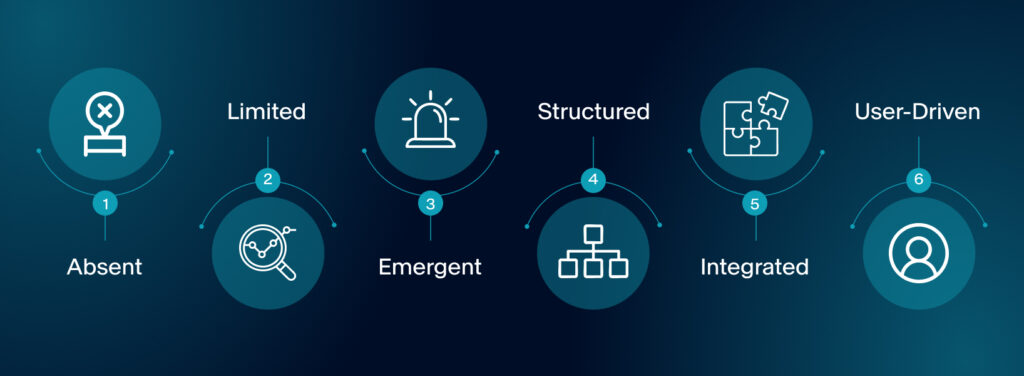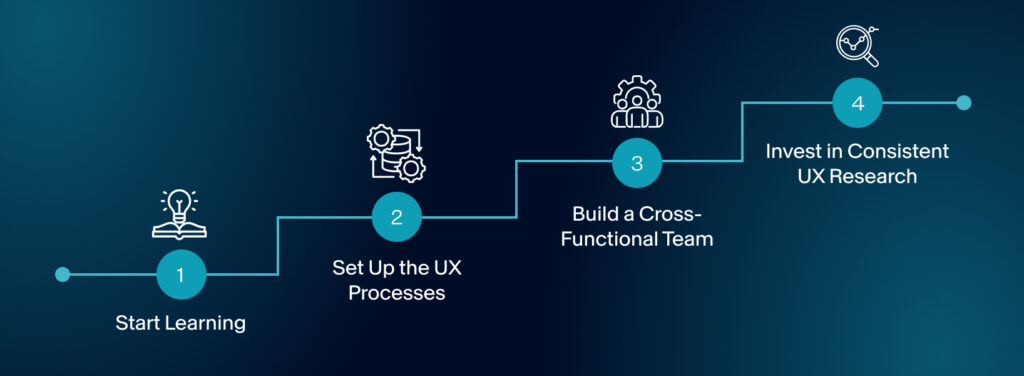In today’s competitive digital economy, having a great product is not enough. Companies must deliver experiences that feel seamless, intuitive, and emotionally resonant—not just meeting business goals and metrics. That’s where UX maturity models come to your rescue. It is a framework to measure how well an organization’s digital product producing processes, design practices, and culture align with its organizational values and strategy.
Understanding your level of UX maturity isn’t just an academic exercise for people who create the foundations of the organization; it’s for everyone involved in the success of this organization. It determines whether your digital product’s experience is driven by informed user research or compromised by assumptions made for a hasty delivery; whether UX is an afterthought or fully integrated into your development process; whether your team is reactive to users’ complaints or strategically user centric.
Stuti Mazumdar - October 2025

What Is the UX Maturity Model?
The UX maturity model, most famously articulated by the Nielsen Norman Group, outlines the stages of UX maturity of an organization and how it helps them judge its UX-related strengths and weaknesses as it scales up its operations. These models help identify where you stand in adopting user centered design as a framework and a scalable discipline, not just a choice made for select projects.
In essence, UX maturity describes how deeply user research, good UX design practices, and usability testing are embedded into your organization’s DNA. With a high UX maturity in your organization, UX professionals working with digital products are empowered to influence decisions early in the design process.
Since good design principles are the forethought, it leads to a shorter UX maturity gap. Without this maturity, design often becomes a cosmetic fix applied at the end, disconnected from strategy.
Your level of UX maturity determines the quality, speed, and impact of your product’s evolution. At low maturity, teams tend to work reactively, making last-minute quick fixes that hold the fort together and pushing releases without validating designs. This often results in a higher volume of redesign requests, inconsistent user experiences, and frustrated users.
In contrast, a high UX maturity organization treats design as a strategic investment. This results in reduced rework and development costs by validating early through usability tests. In addition, organizations like these have shorter design-to-launch cycles because design processes are streamlined, acting as guardrails to help UX professionals create consistent and intuitive experiences from the get go.
The Six Stages of UX Maturity

While different maturity models vary slightly, the Nielsen Norman Group’s model—which we specifically chose to break down today—organizes it into six stages:
1. Absent
Here, UX is not recognized as a discipline. Products are built based solely on business goals and requirements, with no structured UX processes set up by UX professionals. Decisions are driven by stakeholders who leverage internal perspectives, and no user research is conducted to validate assumptions.
2. Limited
Some UX work takes place in the organization, but it’s irregular, tactical, and often outsourced. It may focus on visual aesthetics rather than usability, owing to the disjoint efforts by a number of teams working on the different parts of the overall experience. The work is often isolated efforts to meet certain business goals, but disconnected from the organization’s vision, and there’s little understanding of the long-term value of UX.
3. Emergent
A few UX professionals or a small UX team begin introducing structured activities like basic usability tests when building prototypes or persona creation before they start designing. However, these efforts are project-based and hence, make them less impactful.
4. Structured
Here is where organizations document their good UX processes and design frameworks. Teams begin involving UX earlier in the development process with user research at the front foot, starting to influence product direction. A style guide or early-stage design system may be in place to ensure consistency in such cases.
5. Integrated
UX is embedded across disciplines. UX professionals collaborate closely with stakeholders, product managers, engineers, and marketing teams to ensure a cohesive experience for users. User centricity drives decision-making here, and insights from user research influence roadmaps and business goals directly.
6. User-Driven
User centered design is non-negotiable and deeply ingrained in the culture. UX is viewed as a strategic advantage, with constant usability testing, user feedback loops scheduled, and measurable ROI on every design decision made. UX teams operate at the same strategic level as product leadership, guiding innovation, not just execution.
How to Assess The UX Maturity of Your Organization?
Evaluating maturity isn’t just about where UX lives in the organization—it’s about how decisions are made and executed.
1. Team’s Attitude Towards UX
Ask yourself this, next time you plan a sprint. Is UX seen as decoration or as a business driver? If it’s only mentioned in the context of making the experience look good without delivering users any value, you’re likely operating in the lower stages of maturity. In high maturity environments, UX has a seat at the strategic table and influences core business goals.
2. Integration into the Product Planning Lifecycle
In mature organizations, UX professionals are part of early planning sessions, defining product requirements and scope alongside product managers. In low maturity settings, UX comes into play when product requirements have been defined by the business, while they insist on writing code along with design sprints.
3. Depth of User Research
High maturity teams don’t wait for problems to surface. They run ongoing user research routinely as product hygiene activities. These include user interviews, heuristic analysis, scanning reviews, and ethnographic studies to proactively inform and elevate the organization’s design strategy. At low maturity, research is sporadic and often skipped to save time.
4. Consistency in UX Practices
A robust design system is a hallmark of an organization’s maturity. If your UI components, terminology, and animation patterns are inconsistent, you’re likely accumulating UX debt. Mature organizations have documented UX processes that prevent each project from starting from scratch.
Moving Up the UX Maturity Ladder

Progressing through the stages of UX maturity is a complete cultural shift in an organization, not just a checklist for people involved in designing the product.
1. Start Learning
Train stakeholders on the business value of user centered design. Share internal and industry examples where good UX increased revenue or retention, allowing them to understand how great UX processes can be leveraged to deliver impactful experiences.
2. Set Up The UX Processes
Document when and how design tasks or initiatives are brought up when product discussions take place, how usability tests are run, how research is conducted, and how design integrates with the development process. Solve the problems as you see them coming, and you’ll end up with a seamless design process that truly works.
3. Build a Cross-Functional Team
Siloed UX professionals struggle to scale impact. A mature UX function brings together researchers, designers, content strategists, and developers to work toward shared business goals.
4. Invest in Consistent UX Research
Move beyond project-based user research. Ongoing user research ensures you’re making decisions based on real behaviors and not assumptions, regardless of which part of the digital product the team is working on.



